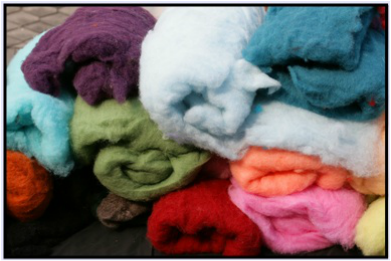Silk Road Souvenirs
Hand-Made Felt

Make Your Own Felt
Felt is a lightweight and relatively waterproof, unwoven fabric of matted or compressed fibers, such as wool. Nomads of the Xinjiang (shin-jiang) province often used felt for their clothes and their homes, called yurts. Because making felt requires no weaving, it could be made easily while the nomads of the Tarim Basin moved from place to place.
To make felt, nomadic horsemen tied up bundles of woolen fibers and placed them under their horses’ saddles. The weight and movement of the rider during a day’s riding compressed the fibers into a simple, felt fabric. This process was repeated several times until the felt was dense enough to be used for making clothing or shelter.
Felt is a lightweight and relatively waterproof, unwoven fabric of matted or compressed fibers, such as wool. Nomads of the Xinjiang (shin-jiang) province often used felt for their clothes and their homes, called yurts. Because making felt requires no weaving, it could be made easily while the nomads of the Tarim Basin moved from place to place.
To make felt, nomadic horsemen tied up bundles of woolen fibers and placed them under their horses’ saddles. The weight and movement of the rider during a day’s riding compressed the fibers into a simple, felt fabric. This process was repeated several times until the felt was dense enough to be used for making clothing or shelter.
What You Need (to make a 20” square piece of felt):
- Bathtub
- One color of 5-6 oz. dyed Merino wool top
- pure wool roving
- Several bath towels
- Straw beach mat, Chinese blind, or sushi rolling mat (larger than 24 inches)
- Liquid laundry detergent
- Empty squeeze bottle (such as those used for dish soap)
- Gloves
- Ruler
- Additional dyed Merino wool top pure wool roving (Optional)
- Bits of yarn (Optional)

Directions:
- Place the liquid laundry detergent into the squeeze bottle.
- Place some towels on the bathroom floor.
- Place the mat on top of the towels.
- Pull all the wool off of one color of roving into small clumps, about 4-6 inches in length.
- Lay the wool pieces on top of the mat. Be sure to lay each piece vertically and overlap each piece slightly to form a 24” square.
- Squeeze a thin layer of laundry detergent in rows, approximately two inches apart, over the entire square of wool.
- Lay another layer of wool roving on top of the first layer. This time, arrange the wool horizontally.
- Squeeze another thin layer of laundry detergent.
- Repeat steps 5 through 8 until the square of wool is 1 ½ – 2 inches high. There should be about 4 – 6 layers of wool until the square reaches that height.
- Optional: Place a different color of roving and/or bits of yarn on the top layer of the square. Add another thin layer of laundry detergent.
- Roll the mat over the wool square.
- Fill the bathtub with 1 – 2 inches of hot water.
- Put on gloves and immerse the rolled mat into the water. Turn the roll back and forth to ensure the wool is thoroughly wet for 3 – 4 minutes.
- Remove the mat from the bathtub, and unroll it gently onto the towel. The felt is quite fragile at this point, so gently lift it from the mat.
- Turn the felt on the straw mat so bottom of the piece is now located on the left side of the mat.
- Re-roll the felt and place it back into the hot bathtub water. If the water has cooled, drain the tub, and refill with hot water. Roll and turn the beach mat for another 3 – 4 minutes. Turn the felt another 3 or 4 times, and reroll in the hot water for about 3 – 5 minutes between each turn.
- Test the felt by rubbing it with your finger. The fibers shouldn’t move and the felt should be quite thick. If it is still soft, turn it again and keep rolling it in the hot water.
- Remove the felt from the mat and rinse in cool water.
- Place the felt on a dry towel and roll the towel. Place it on the floor and stomp on it (barefoot) to remove the excess water.
- Lay the felt flat to dry onto a dry towel. Activity adapted from:http://www.allfiberarts.com/library/felt/blfelt.htm

